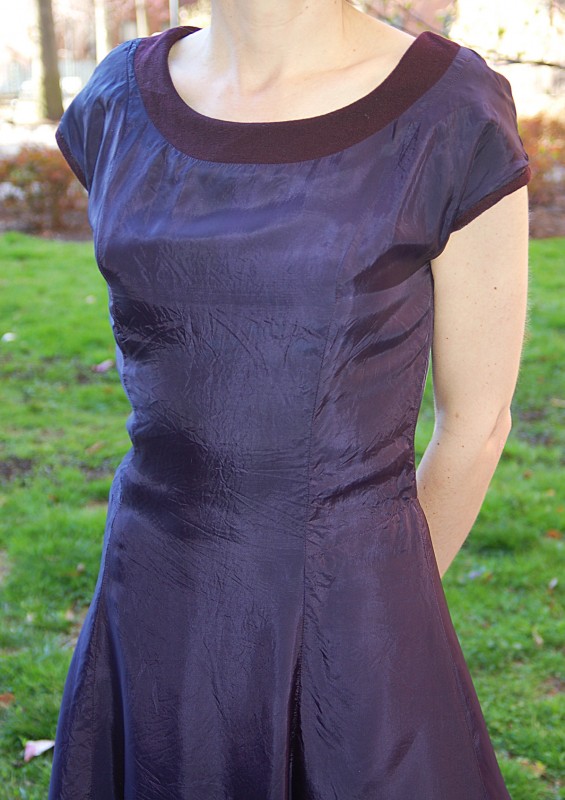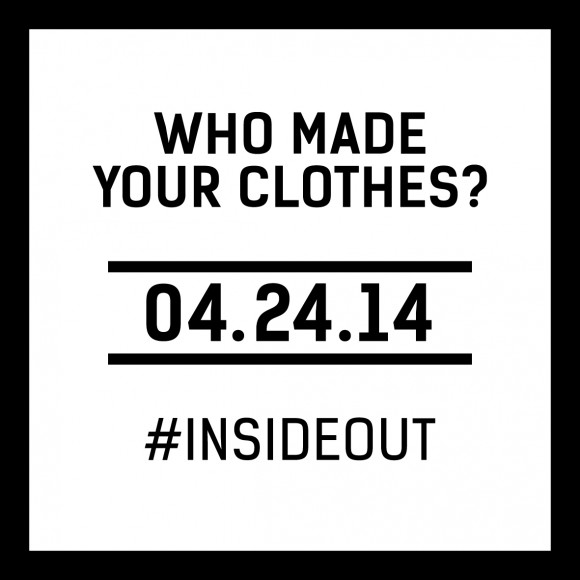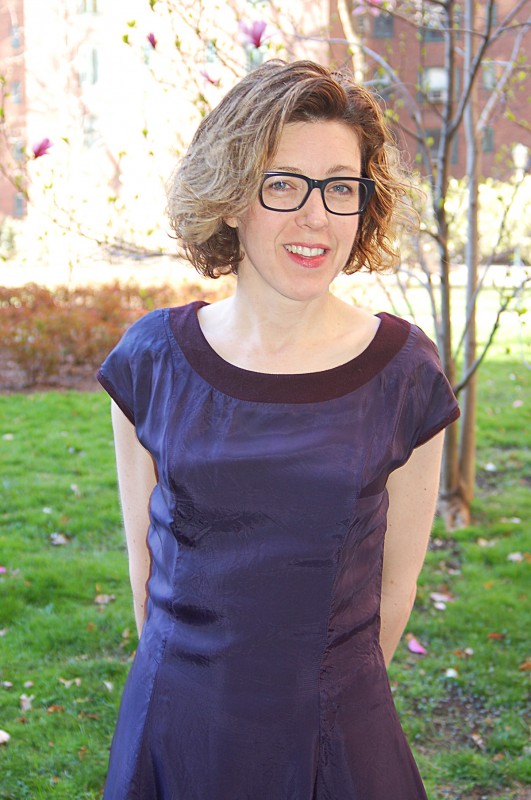I sent my kid to school today wearing all her clothes inside out. She was excited, of course. I mean, what nine-year-old wouldn’t be excited at a chance to wear her clothes inside out?
But as she got dressed we had a lengthy conversation about why today was special inside-out day. First, I needed to be sure she could remember the words “Fashion Revolution.” Revolution is difficult to pronounce when you’re nine. But then I wanted her to understand that Revolution means Big Change. And that by wearing her clothes inside out today she’s asking the question, “Who made your clothes?” and encouraging Big Change in how we think about, purchase, and wear our clothing. We want Big Change from ourselves and from the fashion industry.
We also discussed the Rana Plaza tragedy and the number of people killed and injured in the factory collapse one year ago today. S immediately drew a parallel between Rana Plaza and the Triangle Shirtwaist Fire. (Kid’s got a memory!) Then we discussed why it matters who makes our clothes, what their working conditions are like, and how much they’re paid.
As she got dressed, she asked me about each piece of clothing she was wearing. We talked about the skirt I made her (which actually looks pretty good inside out!). We talked about the labels inside her other clothing, whether the people who made those clothes were paid a living wage, and whether we could feel good about buying and wearing those clothes.
For her two-year-old Zara cardigan and Old Navy leggings, I’m certain the makers probably weren’t paid enough and the labor practices were less than stellar, and we probably won’t buy anything more from those companies unless their business practices change. For one item I was able to tell her that I’ve investigated the company and feel OK about their business practices but I think they could be doing a lot more. (Keep improving, J. Crew!) And for her Lands’ End backpack I had to admit that I don’t know. We’ll do some research about that company tonight. If she could have turned her sneakers and backpack inside out, she would have, but she chose her New Balance sneakers over her Lands’ End school shoes because I told her New Balance makes many of their shoes in the U.S.
That was enough for one kid to remember for one day. I can guarantee she’ll be talking about this to her friends, which is exactly what I had hoped she would do. And tonight we’ll talk about waste and consumption and how it’s important that we don’t buy (or make!) more than we really need.

I’m wearing my Lisette Attache Dress inside out. And let me tell you, the lining side is much more comfortable than the wool crepe side! One of these days I need to teach you how to make your own lining, I know.
Here’s a nice article about Fashion Revolution Day and kids, too.
Anyway, who made your clothes? Do you know? If you don’t, you can go here to start learning. I’m really trying to be more conscious about where I buy my clothes, how much I buy, and how long I wear them. Be part of the Fashion Revolution!
#insideout #handmadeinsideout



Thanks for this post! At the start of the year my wife and I decided to try and only buy clothing we felt was manufactured in a socially responsible way for us and our two kids (4 yrs and 1.5 yrs). I am saddened by how hard that is to do. When it’s just not possible we try to buy used. And now when I sew I am trying to only buy fabric that is ethically sourced, not easy either. It’s made us buy less, appreciate what we have more and start a great conversation with our older child.
Good for you, Cerece! And yes, it’s incredibly difficult, isn’t it? Even organic cotton has many issues. Kudos to you for doing your best. Thanks for commenting!
This is a question I’ve been asking myself for a few years now and I’m so glad to see more and more people asking it too. I have to say, for crafters, when the answer’s often “I did!”, we need to go one step further and ask “Who made my fabric? (and from what raw materials?)”.
Oh, I completely agree! It’s difficult to find out anything about the fabric itself. And I think we also need to be asking ourselves how much we really need! Are we making our own Fast Fashion, or are we wearing and constructing for the long term? All very important points. Thanks!
Hi Liesl,
Thanks for the post! Can I ask you a question? I sewed a dress with Lisette fabric and showed it insideout on my blog. The dress is handmade by me, so no issues there. But I wondered, how is the Chambray fabric made? Do you have more information on that? Thanks! Annelies
That’s a great question, Annalies, and I’m afraid I don’t have a lot of information to give you. I’m going to ask more about our fabrics. I can tell you that most of them are made in China, and that working conditions have been improving in China compared to some other countries, but that’s about all I know right now. Thanks for asking!
You’ve brought up a really interesting point here when you say that we really shouldn’t “buy (or make) more than we really need.” I think a lot about this when I sew. Not only is my closet space extremely limited, which stops me from making every cute pattern I see, I also think about the fabric I use to make clothes with. I really know very little about where it all comes from but I do know that fabric production often results in huge environmental costs. Even something listed as ‘organic’ from China can have very little meaning as they do not have the same labeling standards as we do in the U.S. for organic.
I don’t know if you are aware of this wonderful organization called Fibershed where Rebecca Burgess is leading the charge to create locally produced fibers here in California: http://www.fibershed.com/. She’s a huge inspiration to me!
Sorry to have gotten a bit off topic, but I think this awareness should permeate all aspects of this discussion.
Laura, thanks for this information! I’m not familiar with Fibershed and am interest to read their information. And yes, yes, yes! to your other points. Absolutely, fabric manufacturing requires a lot of natural resources, and organic cotton takes just as much water as regular cotton (a LOT!). Something we ALL need to consider, even if we’re not buying Fast Fashion. Thanks for bringing this up!
I love that you bring up the point about us making our own fast fashion. I mostly make for my two kids, they usually wear things until they’ve either grown out of them or have worn them out. I do see a lot of overconsumption in the blogging sewing community though, at least in my opinion. I know of bloggers that post one, sometimes even two new makes a week, and that to me seems excessive.
Heather, I think it’s something we all need to keep in mind, whether we’re shopping for groceries or sewing clothes. We’re a culture of over-consumption! Thanks for your comment.
Liesl,
Do you have the ability to effect change through the companies that make your fabrics? What about the other American fabric designers you may know? Can you ban together and demand better conditions for your laborers by the manufacturers? I know. I know. That is really hard. And do you have the power?
Sadly, there are almost no American mills anymore.
Maybe everyone could ask Ralph Lauren after the flack he got for his non-American US Olympic uniforms. 😉
I try so hard to find made in America fabrics- for the jobs and the labor practices/laws, but there are so few. JoAnn’s has a small line, but they are all quilt calico styles.
Jenny, it’s all dependent on a number of issues. Our manufacturer could make organic fabric–there are plenty of mills who do it–if the buyers would purchase it. And the buyers would purchase it if consumers would purchase it in stores. It all comes down to the choices we make as consumers. We need to be the force of change for fabric, fashion, food, gas, electricity, etc. If we demand it, companies will produce it. I think we’re on the verge of big changes, and that’s what Fashion Revolution day is all about!
A few things about organic cotton: actually, there are global standards for organic textiles, and you should always be able to find out what standards an organic fabric has been certified to. A Chinese organic fabric isn’t necessarily any less organic than an American one – they may well be certified by the same body. Yes, organic growing takes the same amount of water as conventional cotton, i.e. loads, but that water and nearby waterways don’t get polluted with extremely dangerous chemicals! It’s not a perfect answer, but it’s so much better in so many ways. If you buy your fabric from dedicated ‘ethical’ or organic retailers they usually have plenty of info available about exactly where the fibre came from, how it was processed, etc. It’s only the companies who don’t think about that stuff that can’t give you those details!
Nina, there’s no question that organic cotton uses fewer pesticides. But it’s all so much more complex. Cotton grown in countries where there aren’t many water resources takes water away from the people who live there and need it. So as much as it can help to purchase organic cotton, we also need to think about what that cotton is doing to the communities where it’s growing. There was a wonderful article in the New Yorker a few years ago about this. It’s interesting and frustrating because there are so many issues we should be considering. But how? I think the most important thing is that we just start. If we’re conscious of the problem and making the best choices we can, we’ll change the way we consume and as a result change the way companies do business. Right?
Thanks for this! After I read the book Overdressed (which you linked to above) I got much more angry/serious/riled up about this issue. I’ve since been trying to dress myself and my daughter as much as possible in thrifted or handmade items, but I will admit a good measure of bought-new Children’s Place and Old Navy still creeps into the three-year-old’s wardrobe.
Oh, I know, Mikhaela! I can’t possibly keep up with our business and sewing everything for my family. I need to buy at least some of our clothing. And honestly, I’m ok with that because I want people in need of jobs to have work, too. I think it’s important to remember that we aren’t trying to take jobs away from people–we just want them to be paid a fair wage and to work in safe conditions. So please keep in mind that there’s nothing WRONG with buying clothing. We just want it to be ethically produced clothing. And that change comes from us. If we demand it and are willing to pay for it, it will happen. We’re asking for the fashion industry to change, not go away. But that means paying more and buying less. And that’s our responsibility to ourselves and each other.
these are all such fascinating and complex issues. I have noticed as we moved out of a metropolitan area 10 yrs ago, how much less we buy now. a) there aren’t the stores here to constantly stir up the “I ‘NEED’ that” feeling, and b) there aren’t the all the people to see and places to go to ‘impress’ with this new outfit or that. We are a one (small) income family with 5 children and we definitely wear our clothes until they wear out. Even as parents! We have a closet filled with 20+ boxes of clothes for the kids that we constantly rotate as one grows out of and others grow into.
It frustrates me the price of quality, even though I know it is worth it as usually quality lasts so much longer. and I don’t have a lot of time to make clothes, though I will need to figure it out as I would like longer (below-the-knee) dresses and skirts for my girls that are also stylish/don’t look frumpy. in the meantime, we do a lot of ebay shopping and serious online sale shopping when we have needs. another frustrating thing (which goes for all goods, not just clothes) which goes back to quality, is trying to find clothes that don’t wear out so quickly. I.e. boys pants. – pants should not wear out in 3 months of normal wear!! ugh.
thank you for your article and for making the wonderful designs that you do!
Ralph Lauren Olympic uniforms for Sochi were American made this time around. they sourced
domestic factories, fabrics, yarn spinners, etc. It was a huge undertaking but they did it!
http://www.nydailynews.com/life-style/fashion/ralph-lauren-unveils-new-olympic-sochi-article-1.1588783
I work in the apparel industry and have done business with an American factory and a Canadian factory, sadly both companies eventually went out of business.
Its hard to change our American ways- we want to spend less so we can buy more. Many consumers are not willing to spend 3x as much on a garment and have fewer pieces in their wardrobe.
Liesl,
Thank you for posting the article last week and this week’s follow up so I could participate. While this has been a concern of mine for a number of years, last year’s tragedy forced me to want to make significant changes.
As you stated very well, it’s not about taking away jobs from workers, it’s about being paid a fair living wage and having good working conditions.
I tried sourcing Canadian produced fabric this past fall. The mill I contacted said, they are no longer producing or selling the organic fabrics for the reasons you stated. We need the consumer to realize, we have to 1) purchase said fabric 2) at the proper rate, or the mills go out of business. We need to pay more, which means having less, and that’s ultimately a good thing. 🙂
My skirt I am wearing inside out today, has not been noticed as inside out….I guess people think having all 6 of the seams on the outside are fashionable. 🙂 My vest on the other hand…caught attention. 😉
Darci, I remember all the furor over the Ralph Lauren-designed uniforms, and I felt so bad because there are so few American factories where the company could have made the uniforms! I’m so glad that’s changing, and it’s wonderful that this year’s uniforms were made in the U.S. There’s a big movement in New York for more factories. It’s quite exciting.
Carol, yes, I think it’s important that as sewist we don’t ostracize anyone who doesn’t sew. You’re absolutely correct: it’s not about taking jobs away. It’s about responsible consumption. Buying less and paying appropriately for it. And I don’t think it’s all about buying American-made, either. It’s about paying fair wages and offering safe working conditions. And having less, for sure. We dispose of far too much. And I love that your skirt looks so good that no one is noticing!
So pleased to see this.
My older children have their own income now and there is a great temptation to buy ‘cheap and cheerful’ clothing.
I don’t stop them, but I certainly point out it may be ‘cheap’ but possibly not so ‘cheerful’
The BBC doco ‘Blood, Sweat and T-shirts’ was very helpful to explain the situation to their age demographic.
Very pleased to see this problem being addressed. I find it’s easier to find some information on the origin of clothing, up to the point of manufacturing, but well nigh impossible to find out anything about the fabric the clothing is made from. The same with purchasing fabric. Are you able to tell us about the origins of your fabric line sold in Spotlight stores throughout Australia?
In addition to the water consumption involved in cotton cultivation, I worry about the human costs. Some of my reading indicates that, because organic cotton is more labor intensive to grow than conventionally-grown cotton, it is more likely to involve child and slave labor.
Over the past several years, I’ve grown increasingly skeptical about the benefits of organics. I’m inclined to see organic farming (of just about anything) as a method of producing boutique goods with very little regard for the human costs.
I don’t know how to fix that.
How wonderful to involve your daughter in the cause. I think this is such a far reaching problem and unfortunately, the solutions aren’t clear cut. I am not buying any new fabric this year, just sewing from my stash and my huge repurpose pile! All we can do it try our best.
Thank you for this post. I did not know how else to contact you but I wanted to ask if the Round trip jacket pattern could be made from a knit!!??? Thanks -this post has made me want to make my own clothes more instead of buying from stores where workers get paid less than is required to live onand in deplorable conditions. I plan on reading the stories linked too .
Thanks so much for bringing this issue out in the open again! I read the book Overdressed last summer (after you blogged about it!) and since then have made a concerted effort not to buy new clothes (unless they were responsibly made). I could not possibly keep up with sewing for myself and my three kids, and also have issues with finding fabric that meets my new criteria, but have realized just how much good quality used clothing is out there! We are all possibly even better dressed than before wearing used clothes and I feel good about giving another life to a garment. I also have been trying to sew more staple clothes that I know will get worn rather than the frilly (sometimes silly!!) dresses that are so fun to sew, but that rarely get worn. 🙂 I even upcycled or updated a few garments instead of donating them. I am so thankful for your blog because since I have become more aware of this issue it has also made me change my habits about ALL of our family’s other purchases as well. We are changing our lifestyle and working towards living simply and it really feels good!! Thanks for the inspiration!
There are a handful of good sources for organic fabrics, but as others have mentioned, just because it is organic doesn’t necessarily mean that the workers are treated well. Sometimes you have to accept at least one step in the right direction though and support companies that are at least making some effort.
Some other good companies that I have found this year that seem to be making responsibility a priority are Patagonia, Keen, Timberland, PACT, katequinnorganics, two crows for joy, reyswimwear, and aventuraclothing.